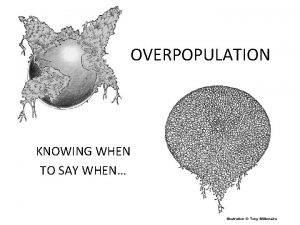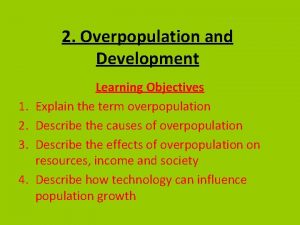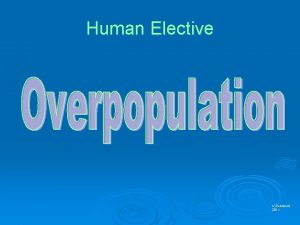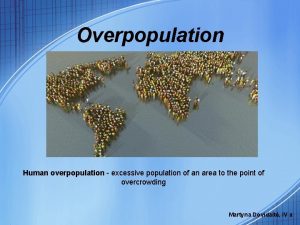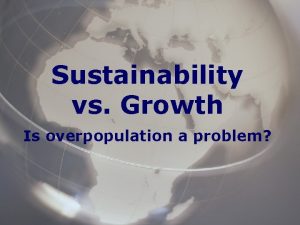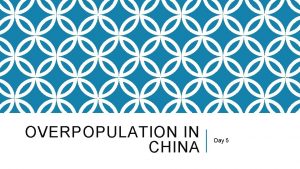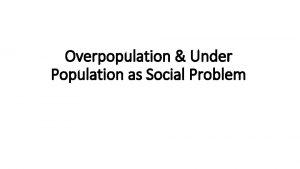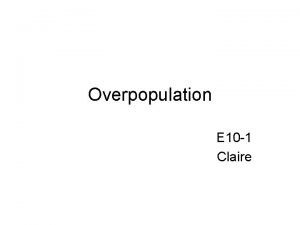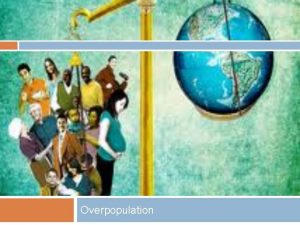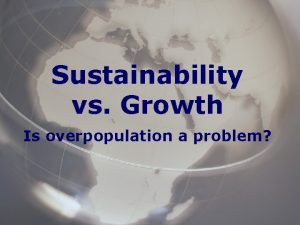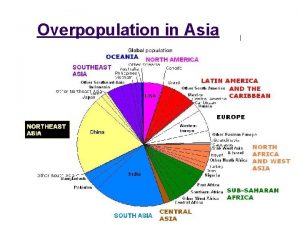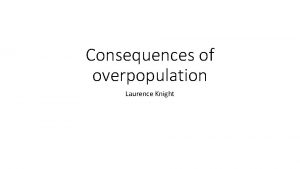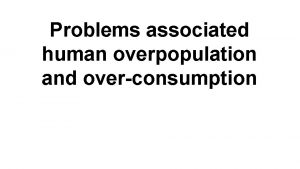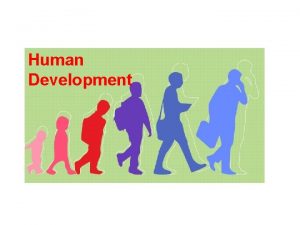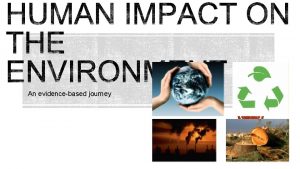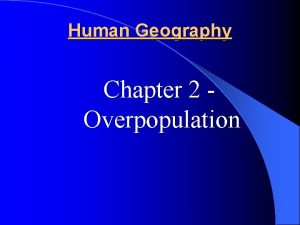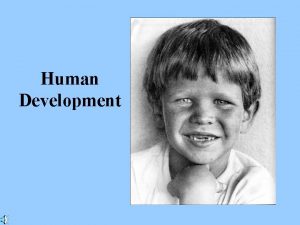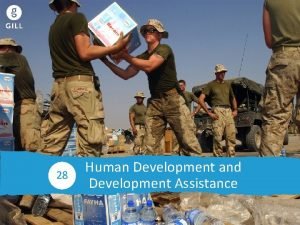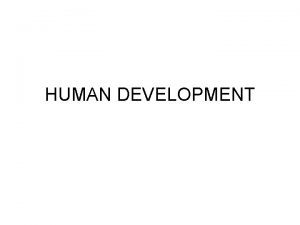2 Human Development Overpopulation The main terms associated

























- Slides: 25

2 Human Development & Overpopulation The main terms associated with human development How poor development of resources can lead to overpopulation How a region’s cultural differences, economic level, population growth, technological advancement and developments can all have a major impact on its population either positively or negatively

Chapter 2: Human Development & Overpopulation § No. of people in a region too many for natural resources to support § Carrying capacity exceeded § Migration – release valve Underpopulation § No. of people living in a region cannot use/exploit the natural resources fully § Inward migration: increases living standards for all Optimum population The no. of people that can exist in a region with an adequate standard living without depleting natural resources.

Population: Resources.

Overpopulated? • Japan • Ethiopia Pop density 336 km₂ Pop density 60 km₂

Carrying Capacity The number of people a region can support Factors that can increase CC: Ø Decreasing pop. Ø Use of fertilisers Ø New farming methods Ø Irrigation Ø Better crops/animals Ø Land reclamation Factors that can decrease CC: Ø Pop. Growth Ø Soil erosion Ø Deforestation Ø Flooding Ø Overgrazing/overcropping Ø Urbanisation/migration Ø Climate change

Chapter 2: Human Development & Overpopulation & resources ● Causes of overpopulation: ● Climate change ● Flooding ● Unsustainable farming methods ● Population growth/high birth rates ● Depletion of resources

Chapter 2: Human Development & Overpopulation & development of resources ● Effects of overpopulation § Socio-economic § Environmental

Characteristics of an over populated area High birth rates Lower life expectancy Lower literacy levels High unemployment Lack of surplus food Poor diet Unhygienic living conditions Financially stretched government • Conflict over resources • • • • Lack of arable land Congestion Overcrowding Urban sprawl Environmental degradation

Link between population and level of development Measuring Development? Income Standard of Living • GNP Total wealth at home and abroad divided by pop • HDI • Index between 0 and 1. 0 • Uses three factors to rank countries according to Human Development - Life expectancy - Literacy rates - GDP adjusted to local cost of living • GDP (Gross domestic product) Total wealth produced in a country minus MNCs divided by pop



Chapter 2: Human Development & Overpopulation Impact of income levels on population growth § Poverty is a cause of high birth rates §large numbers of children seen as economic advantage §In developing countries, dependency on agriculture is high §Children can work to help produce food for family §Governments cannot support families §Children are insurance for the future –provide care to parents in old age §Access to education and healthcare linked to income §As income levels rise, birth rates drop §In developed economies children are seen an economic responsibility due to cost of childcare etc.


Chapter 2: Human Development & Overpopulation Influence of society on population Status of women § Developing world: low status § Less education: India, 62% illiterate § Marry very young, role = produce sons § India: 20% world’s maternal deaths, 25% child deaths

Chapter 2: Human Development & Overpopulation Influence of society on population § Education on family planning § Availability of healthcare § Government policy, eg China, Romania § India: Vasectomy for a radio 1970 s § Promotion of smaller family

Chapter 2: Human Development & Overpopulation Influence of culture on population ● Religion § Strong religious influence = high birth rates § Oppose artificial birth control & abortion § Ireland 1970 s, Catholic; Muslim countries, Saudi Arabia; South America § Catholic influence declining – Italy, 1. 3 births per mother per year

Chapter 2: Human Development & Overpopulation Influence of culture on population ● Local customs § India: no. of children indicates virility § Desire for sons ( dowry) §Traditional view of role of women § Larger families – economic advantage, insurance

Chapter 2: Human Development & Overpopulation Impact of technology on population growth § Agricultural Revolution Improved farming methods Crop rotation Selective breeding Improved irrigation Improved fertilisers GM foods & the Green Revolution New strains of plants disease resistant varieties High yield seeds Use of chemicals ØIncreased food supply

Chapter 2: Human Development & Overpopulation Impact of technology on population growth § Medical improvements Access to primary healthcare Immunisations Disease eradicaton programmes Decrease in infant mortality Longer life expectancy Improved family planning New drugs and treatments

Chapter 2: Human Development & Overpopulation Advances technology can reduce effects of overpopulation Reduces ecological footprint §Increase sustainable use of resources §Afforestation §Composite materials, eg. carbon fibre replacing metals §Renewable energy reduces reliance on fossilfuels §Fuel cells to replace finite oil supply §Eco friendly agriculture eg organic § Reduction of emissions §Recycling conserves resources §

Chapter 2: Human Development & Overpopulation Case Study ● Causes of overpopulation in India § unwise use of resources in Rajasthan region § growing population § large areas of forest cleared § Humification and transpiration interrupted § poor farming practices § over cropping and overgrazing § Soil erosion § Spread of Thar Desert § Infertile and unable to support pop.

Chapter 2: Human Development & Overpopulation & the impacts of society & culture ● Effects of overpopulation in India § Risk of famine § Land very scarce § Migration § Unemployment § Overcrowding

Chapter 2: Human Development & Overpopulation Impact of population growth/decline ● Developing world § South (stages 2/3) § 30% under 14 years § Challenges: basic healthcare & education § Civil wars, corrupt leadership, no MNC investment § Overpopulation § Food security § Agricultural lands – overworked & sterile § Large populations; low wages

Chapter 2: Human Development & Overpopulation Impact of population growth/decline ● Developed world § As economy improves, family size reduces § North (stage 4/5) § Inward migration from South to sustain living standards

Overpopulation: Links between issues Over population Population growth Increased needs Increased consumption Environmental Degradation Declining Resources Scarcity & Poverty Conflict Migration
 Thomas malthus overpopulation
Thomas malthus overpopulation Thomas malthus overpopulation
Thomas malthus overpopulation Thomas malthus overpopulation
Thomas malthus overpopulation Definition of overpopulation
Definition of overpopulation Topics for a problem solution essay
Topics for a problem solution essay The population explosion
The population explosion Idpe process
Idpe process Write the terms associated with ipde process
Write the terms associated with ipde process Cna chapter 8 human needs and human development
Cna chapter 8 human needs and human development Chapter 8 human needs and human development
Chapter 8 human needs and human development Gni definition ap human geography
Gni definition ap human geography Polynomial degrees and terms
Polynomial degrees and terms What are the like terms in the algebraic expression
What are the like terms in the algebraic expression Human anatomy terms
Human anatomy terms Future will
Future will Stated and implied main idea
Stated and implied main idea Void main int main
Void main int main Hát kết hợp bộ gõ cơ thể
Hát kết hợp bộ gõ cơ thể Slidetodoc
Slidetodoc Bổ thể
Bổ thể Tỉ lệ cơ thể trẻ em
Tỉ lệ cơ thể trẻ em Voi kéo gỗ như thế nào
Voi kéo gỗ như thế nào Tư thế worm breton
Tư thế worm breton Hát lên người ơi
Hát lên người ơi Môn thể thao bắt đầu bằng chữ đua
Môn thể thao bắt đầu bằng chữ đua Thế nào là hệ số cao nhất
Thế nào là hệ số cao nhất

